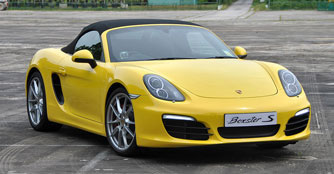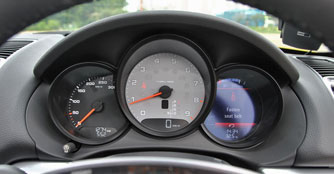Porsche Boxster S 3.4 (A) Review
30 Jul 2012|18,901 views
People buy roadsters by virtue of the fact that they look good (hence making the occupants look good too) and that they have that fun-to-drive quotient. The Porsche Boxster might possibly be the most fun to drive but styling wise, I would never call it pretty or well proportioned. Until now, that is. I doubt you will disagree with me that the latest, third generation Boxster is one pretty topless machine.
Dubbed the 981, the new Boxster replaces the eight-year old 987 model as Porsche's entry-level sports car. As previously, the new Boxster range consists of an entry-level model powered by a 2.7-litre motor, down from the previous model's 2.9-litre unit as well as the more powerful 3.4-litre Boxster S variant.
Exterior
On the outside, the new model can be easily distinguished from earlier generation Boxsters despite the familiar profile and silhouette. In terms of proportions, the 981 has a 60mm longer wheelbase, noticeably shorter overhangs and wider tracks for a squarer footprint than previously. Coupled to the repositioned windscreen base and lower height, the Boxster looks sleeker and more squat than ever.
When it comes to styling details, the new model seems to be inspired by the 991 generation 911 as well as the iconic Carrera GT super car. The shape of the headlamps, the air inlets along the Boxster's flanks and the tail lamps all mimic the Carrera GT's while the active rear spoiler now extends to form part of the tail lamps.
Wheel sizes have increased to 19-inch on the Boxster S with the car tested here wearing upsized 20s to fill those wheel arches even more convincingly. Like the previous generation 986 and 987 models, the Boxster S is differentiated from the lesser Boxster via the badges on the rear deck and its twin exhaust tips with the base model featuring a single oval-shaped exhaust.
Dubbed the 981, the new Boxster replaces the eight-year old 987 model as Porsche's entry-level sports car. As previously, the new Boxster range consists of an entry-level model powered by a 2.7-litre motor, down from the previous model's 2.9-litre unit as well as the more powerful 3.4-litre Boxster S variant.
Exterior
On the outside, the new model can be easily distinguished from earlier generation Boxsters despite the familiar profile and silhouette. In terms of proportions, the 981 has a 60mm longer wheelbase, noticeably shorter overhangs and wider tracks for a squarer footprint than previously. Coupled to the repositioned windscreen base and lower height, the Boxster looks sleeker and more squat than ever.
When it comes to styling details, the new model seems to be inspired by the 991 generation 911 as well as the iconic Carrera GT super car. The shape of the headlamps, the air inlets along the Boxster's flanks and the tail lamps all mimic the Carrera GT's while the active rear spoiler now extends to form part of the tail lamps.
Wheel sizes have increased to 19-inch on the Boxster S with the car tested here wearing upsized 20s to fill those wheel arches even more convincingly. Like the previous generation 986 and 987 models, the Boxster S is differentiated from the lesser Boxster via the badges on the rear deck and its twin exhaust tips with the base model featuring a single oval-shaped exhaust.
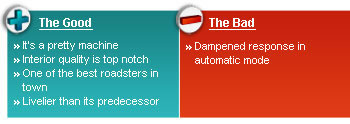 |
The new Boxster features a new, fully electrically operated roof that stows away in a matter of seconds with just the press of a button, a luxury that wasn't available in older generation cars as you'd need to manually unlatch a lever to unlock the roof locking mechanism on the windscreen frame before the hydraulics take over to electrically lower the roof.
The new model also makes do without a tonneau cover for the retracted roof once the latter is stored behind the passenger compartment.
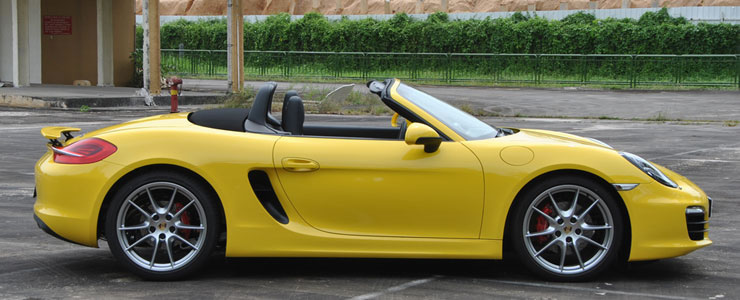 |
Like the 911 Cabriolet, the roof can be operated on the move at speeds of up to 50km/h. The glass rear window also features heating elements for added convenience.
Interior
Inside, the Boxster features an all-new interior that shares design cues with other current Porsche models like the 911, Cayenne and Panamera. Just like the cabins of the abovementioned models, the rising centre console plays a prominent role in the design of the new cabin.
As previously, the Boxster's instrument binnacle features three circular dials with the rev counter sitting centre stage while the right dial features a large multi-function screen counter that displays information like lap times, additional parameters like oil temperature and pressure as well as a device that measure g forces. With the new cabin, overall perceived quality and luxury is higher than in the old 987 model.
Interior
Inside, the Boxster features an all-new interior that shares design cues with other current Porsche models like the 911, Cayenne and Panamera. Just like the cabins of the abovementioned models, the rising centre console plays a prominent role in the design of the new cabin.
As previously, the Boxster's instrument binnacle features three circular dials with the rev counter sitting centre stage while the right dial features a large multi-function screen counter that displays information like lap times, additional parameters like oil temperature and pressure as well as a device that measure g forces. With the new cabin, overall perceived quality and luxury is higher than in the old 987 model.
The Drive
The Boxster's USP has always been about the way it drives and its ability to entertain drivers and this new 981 is no different. With the 981, Porsche claims that the new model not only matches the dynamic qualities if the previous models but also surpasses them. According to Porsche, the 981 can lap the famed Nurburgring Nordschleife 12 seconds quicker than its predecessor.
On the road, the new model does feel marginally more agile and dynamic than the 987 it replaces. The steering responses sharply to each of the driver's inputs helping the Boxster to swap directions like a scalded cat.
Just like the 991 generation 911, the Boxster range utilises a new electro-mechanical steering system that somehow manages to retain the positive attributes of the old car's hydraulic power steering system, which means the helm is superbly weighted and relays high levels of feel and feedback to the driver's palms. The chassis generates high levels of grip for the Boxster to cling on mercilessly to the desired cornering line while the wider track and longer wheelbase do improve stability at higher speeds.
On the refinement front, the new model rides better and is more refined overall than its predecessor, an improvement that is shared with the recent new 911.
The Boxster's USP has always been about the way it drives and its ability to entertain drivers and this new 981 is no different. With the 981, Porsche claims that the new model not only matches the dynamic qualities if the previous models but also surpasses them. According to Porsche, the 981 can lap the famed Nurburgring Nordschleife 12 seconds quicker than its predecessor.
On the road, the new model does feel marginally more agile and dynamic than the 987 it replaces. The steering responses sharply to each of the driver's inputs helping the Boxster to swap directions like a scalded cat.
Just like the 991 generation 911, the Boxster range utilises a new electro-mechanical steering system that somehow manages to retain the positive attributes of the old car's hydraulic power steering system, which means the helm is superbly weighted and relays high levels of feel and feedback to the driver's palms. The chassis generates high levels of grip for the Boxster to cling on mercilessly to the desired cornering line while the wider track and longer wheelbase do improve stability at higher speeds.
On the refinement front, the new model rides better and is more refined overall than its predecessor, an improvement that is shared with the recent new 911.
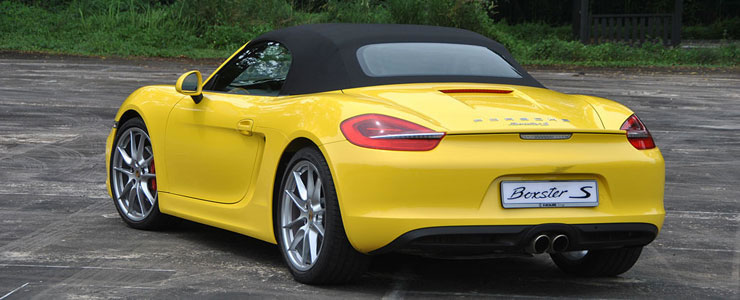 |
While the base Boxster features a downsized engine, the Boxster S sticks to a 3436cc DFI Direct Fuel Injection flat-six that has gained a modest power boost. The 981's unit makes a minute 5bhp more than previously, bringing the horsepower total to 315bhp at 6700rpm. Peak torque output is a similar 360Nm as previously but is now available at a slightly wider rev band.
With the optional Sport Chrono Pack set to Sport +, the Boxster S will return a 0-100km/h time of 4.8 seconds, almost half a second quicker than the old car's time. The faster acceleration time can be attributed more to the new model's 30kg lighter weight when compared to its predecessor rather than its additional 5bhp.
Despite the modest gains in power and performance numbers, the new model somehow manages to feel livelier than before thanks to the engine's slightly more flexible nature among other factors. The new car's motor somehow just doesn't feel as lazy as the old car's at low speeds and in the mid-range. Like the 911, one of the best and unique aspects of the Boxster driving experience is listening to that flat-6 mechanical symphony just behind your ears.
Fuel efficiency is an important factor in modern engines these days. In the case of the Boxster S, the new model drinks up to 1 litre less for every 100km travelled thanks to new fuel saving measures like electrical system recuperation, thermal management as well as coasting for models fitted with the PDK transmission.
With the optional Sport Chrono Pack set to Sport +, the Boxster S will return a 0-100km/h time of 4.8 seconds, almost half a second quicker than the old car's time. The faster acceleration time can be attributed more to the new model's 30kg lighter weight when compared to its predecessor rather than its additional 5bhp.
Despite the modest gains in power and performance numbers, the new model somehow manages to feel livelier than before thanks to the engine's slightly more flexible nature among other factors. The new car's motor somehow just doesn't feel as lazy as the old car's at low speeds and in the mid-range. Like the 911, one of the best and unique aspects of the Boxster driving experience is listening to that flat-6 mechanical symphony just behind your ears.
Fuel efficiency is an important factor in modern engines these days. In the case of the Boxster S, the new model drinks up to 1 litre less for every 100km travelled thanks to new fuel saving measures like electrical system recuperation, thermal management as well as coasting for models fitted with the PDK transmission.
Speaking of the PDK, the Boxster S' has been recalibrated to be smoother at low speeds and quicker with its shifts at higher speeds, just like in the new 911. On the downside, the box's new coasting function might save fuel but it dampens response a tad in automatic mode as it'll take a moment or two before a gear hooks up once again when coasting down to a slower speed. Thankfully, this doesn't happen when the box is switched to manual mode.
Conclusion
With its latest revamp, the Boxster finally has the pretty looks to match its sublime driving characteristics, further distancing itself from its competitors to become the undisputed leader of the roadster pack.
Conclusion
With its latest revamp, the Boxster finally has the pretty looks to match its sublime driving characteristics, further distancing itself from its competitors to become the undisputed leader of the roadster pack.
People buy roadsters by virtue of the fact that they look good (hence making the occupants look good too) and that they have that fun-to-drive quotient. The Porsche Boxster might possibly be the most fun to drive but styling wise, I would never call it pretty or well proportioned. Until now, that is. I doubt you will disagree with me that the latest, third generation Boxster is one pretty topless machine.
Dubbed the 981, the new Boxster replaces the eight-year old 987 model as Porsche's entry-level sports car. As previously, the new Boxster range consists of an entry-level model powered by a 2.7-litre motor, down from the previous model's 2.9-litre unit as well as the more powerful 3.4-litre Boxster S variant.
Exterior
On the outside, the new model can be easily distinguished from earlier generation Boxsters despite the familiar profile and silhouette. In terms of proportions, the 981 has a 60mm longer wheelbase, noticeably shorter overhangs and wider tracks for a squarer footprint than previously. Coupled to the repositioned windscreen base and lower height, the Boxster looks sleeker and more squat than ever.
When it comes to styling details, the new model seems to be inspired by the 991 generation 911 as well as the iconic Carrera GT super car. The shape of the headlamps, the air inlets along the Boxster's flanks and the tail lamps all mimic the Carrera GT's while the active rear spoiler now extends to form part of the tail lamps.
Wheel sizes have increased to 19-inch on the Boxster S with the car tested here wearing upsized 20s to fill those wheel arches even more convincingly. Like the previous generation 986 and 987 models, the Boxster S is differentiated from the lesser Boxster via the badges on the rear deck and its twin exhaust tips with the base model featuring a single oval-shaped exhaust.
Dubbed the 981, the new Boxster replaces the eight-year old 987 model as Porsche's entry-level sports car. As previously, the new Boxster range consists of an entry-level model powered by a 2.7-litre motor, down from the previous model's 2.9-litre unit as well as the more powerful 3.4-litre Boxster S variant.
Exterior
On the outside, the new model can be easily distinguished from earlier generation Boxsters despite the familiar profile and silhouette. In terms of proportions, the 981 has a 60mm longer wheelbase, noticeably shorter overhangs and wider tracks for a squarer footprint than previously. Coupled to the repositioned windscreen base and lower height, the Boxster looks sleeker and more squat than ever.
When it comes to styling details, the new model seems to be inspired by the 991 generation 911 as well as the iconic Carrera GT super car. The shape of the headlamps, the air inlets along the Boxster's flanks and the tail lamps all mimic the Carrera GT's while the active rear spoiler now extends to form part of the tail lamps.
Wheel sizes have increased to 19-inch on the Boxster S with the car tested here wearing upsized 20s to fill those wheel arches even more convincingly. Like the previous generation 986 and 987 models, the Boxster S is differentiated from the lesser Boxster via the badges on the rear deck and its twin exhaust tips with the base model featuring a single oval-shaped exhaust.
 |
The new Boxster features a new, fully electrically operated roof that stows away in a matter of seconds with just the press of a button, a luxury that wasn't available in older generation cars as you'd need to manually unlatch a lever to unlock the roof locking mechanism on the windscreen frame before the hydraulics take over to electrically lower the roof.
The new model also makes do without a tonneau cover for the retracted roof once the latter is stored behind the passenger compartment.
 |
Like the 911 Cabriolet, the roof can be operated on the move at speeds of up to 50km/h. The glass rear window also features heating elements for added convenience.
Interior
Inside, the Boxster features an all-new interior that shares design cues with other current Porsche models like the 911, Cayenne and Panamera. Just like the cabins of the abovementioned models, the rising centre console plays a prominent role in the design of the new cabin.
As previously, the Boxster's instrument binnacle features three circular dials with the rev counter sitting centre stage while the right dial features a large multi-function screen counter that displays information like lap times, additional parameters like oil temperature and pressure as well as a device that measure g forces. With the new cabin, overall perceived quality and luxury is higher than in the old 987 model.
Interior
Inside, the Boxster features an all-new interior that shares design cues with other current Porsche models like the 911, Cayenne and Panamera. Just like the cabins of the abovementioned models, the rising centre console plays a prominent role in the design of the new cabin.
As previously, the Boxster's instrument binnacle features three circular dials with the rev counter sitting centre stage while the right dial features a large multi-function screen counter that displays information like lap times, additional parameters like oil temperature and pressure as well as a device that measure g forces. With the new cabin, overall perceived quality and luxury is higher than in the old 987 model.
The Drive
The Boxster's USP has always been about the way it drives and its ability to entertain drivers and this new 981 is no different. With the 981, Porsche claims that the new model not only matches the dynamic qualities if the previous models but also surpasses them. According to Porsche, the 981 can lap the famed Nurburgring Nordschleife 12 seconds quicker than its predecessor.
On the road, the new model does feel marginally more agile and dynamic than the 987 it replaces. The steering responses sharply to each of the driver's inputs helping the Boxster to swap directions like a scalded cat.
Just like the 991 generation 911, the Boxster range utilises a new electro-mechanical steering system that somehow manages to retain the positive attributes of the old car's hydraulic power steering system, which means the helm is superbly weighted and relays high levels of feel and feedback to the driver's palms. The chassis generates high levels of grip for the Boxster to cling on mercilessly to the desired cornering line while the wider track and longer wheelbase do improve stability at higher speeds.
On the refinement front, the new model rides better and is more refined overall than its predecessor, an improvement that is shared with the recent new 911.
The Boxster's USP has always been about the way it drives and its ability to entertain drivers and this new 981 is no different. With the 981, Porsche claims that the new model not only matches the dynamic qualities if the previous models but also surpasses them. According to Porsche, the 981 can lap the famed Nurburgring Nordschleife 12 seconds quicker than its predecessor.
On the road, the new model does feel marginally more agile and dynamic than the 987 it replaces. The steering responses sharply to each of the driver's inputs helping the Boxster to swap directions like a scalded cat.
Just like the 991 generation 911, the Boxster range utilises a new electro-mechanical steering system that somehow manages to retain the positive attributes of the old car's hydraulic power steering system, which means the helm is superbly weighted and relays high levels of feel and feedback to the driver's palms. The chassis generates high levels of grip for the Boxster to cling on mercilessly to the desired cornering line while the wider track and longer wheelbase do improve stability at higher speeds.
On the refinement front, the new model rides better and is more refined overall than its predecessor, an improvement that is shared with the recent new 911.
 |
While the base Boxster features a downsized engine, the Boxster S sticks to a 3436cc DFI Direct Fuel Injection flat-six that has gained a modest power boost. The 981's unit makes a minute 5bhp more than previously, bringing the horsepower total to 315bhp at 6700rpm. Peak torque output is a similar 360Nm as previously but is now available at a slightly wider rev band.
With the optional Sport Chrono Pack set to Sport +, the Boxster S will return a 0-100km/h time of 4.8 seconds, almost half a second quicker than the old car's time. The faster acceleration time can be attributed more to the new model's 30kg lighter weight when compared to its predecessor rather than its additional 5bhp.
Despite the modest gains in power and performance numbers, the new model somehow manages to feel livelier than before thanks to the engine's slightly more flexible nature among other factors. The new car's motor somehow just doesn't feel as lazy as the old car's at low speeds and in the mid-range. Like the 911, one of the best and unique aspects of the Boxster driving experience is listening to that flat-6 mechanical symphony just behind your ears.
Fuel efficiency is an important factor in modern engines these days. In the case of the Boxster S, the new model drinks up to 1 litre less for every 100km travelled thanks to new fuel saving measures like electrical system recuperation, thermal management as well as coasting for models fitted with the PDK transmission.
With the optional Sport Chrono Pack set to Sport +, the Boxster S will return a 0-100km/h time of 4.8 seconds, almost half a second quicker than the old car's time. The faster acceleration time can be attributed more to the new model's 30kg lighter weight when compared to its predecessor rather than its additional 5bhp.
Despite the modest gains in power and performance numbers, the new model somehow manages to feel livelier than before thanks to the engine's slightly more flexible nature among other factors. The new car's motor somehow just doesn't feel as lazy as the old car's at low speeds and in the mid-range. Like the 911, one of the best and unique aspects of the Boxster driving experience is listening to that flat-6 mechanical symphony just behind your ears.
Fuel efficiency is an important factor in modern engines these days. In the case of the Boxster S, the new model drinks up to 1 litre less for every 100km travelled thanks to new fuel saving measures like electrical system recuperation, thermal management as well as coasting for models fitted with the PDK transmission.
Speaking of the PDK, the Boxster S' has been recalibrated to be smoother at low speeds and quicker with its shifts at higher speeds, just like in the new 911. On the downside, the box's new coasting function might save fuel but it dampens response a tad in automatic mode as it'll take a moment or two before a gear hooks up once again when coasting down to a slower speed. Thankfully, this doesn't happen when the box is switched to manual mode.
Conclusion
With its latest revamp, the Boxster finally has the pretty looks to match its sublime driving characteristics, further distancing itself from its competitors to become the undisputed leader of the roadster pack.
Conclusion
With its latest revamp, the Boxster finally has the pretty looks to match its sublime driving characteristics, further distancing itself from its competitors to become the undisputed leader of the roadster pack.
Car Information
Porsche Boxster S PDK 3.4 (A)
CAT B|Petrol|12.5km/L
Horsepower
235kW (315 bhp)
Torque
360 Nm
Acceleration
5sec (0-100km /hr)
This model is no longer being sold by local distributor
All Used Porsche BoxsterThank You For Your Subscription.





















